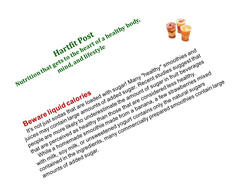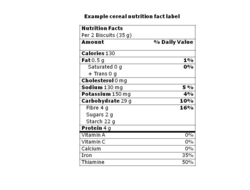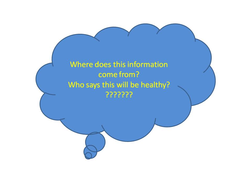Scientific research: Searching for the "truth"
Published: August 06, 2021
Have you ever wondered where the myriad of nutritional health and physical activity information comes from? How do you know the information is correct?
When your friend says “they say” or “I heard that” how do you know that what she says is factual and not rumour?
After all, you probably want to base your healthy eating and physical activity practices on information that will actually help provide health benefits and not adversely affect you.
Nutritional health and physical activity educators also want to make sure that the knowledge which underpins guidelines for healthy nutrition and physical activity is correct.
To ensure that these guidelines will help people achieve and maintain good health the knowledge base must be supported by a significant amount of scientific evidence which shows that by eating in a particular way, and being physically active people will be healthy.
The evidence is the outcome of research in many different scientific fields which are concerned with nutrition, physical activity, and health.
While there is very little that can be "proven" to be 100% "true", understanding how research for health related nutrition and physical activity guidelines is carried out can help you to determine which information is worth keeping, and which you should treat with caution.
Research methodologies
There are many research methodologies. Some are quantitative (numerical evaluation) and others are qualitative (descriptive).
The two main research study methodologies used for health related nutrition and physical activity studies are epidemiological studies and experimental studies. Subcategories exist within each of these methodologies.
Epidemiological studies are observational studies performed on groups of people or particular population groups.
A cross-sectional epidemiological study may observe a large population group to study the foods they eat and their health outcomes.
Findings may identify a particular factor which improves or adversely affects health. The types of, and how much physical activity benefits or adversely affects health can also be studied this way.
Researchers use case-control studies to compare a group of people with a disease with a similar group of people without the disease to establish which variable may be responsible for the presence or lack of disease.
Cohort research studies follow a specific group of people over time, collecting data at specified intervals to report health outcomes at the end of the term of the study.
Experimental trials are laboratory or clinical trials and include animal studies, in vitro (test tube), and human intervention trials.
Limitations of research methodologies
No research methodology is perfect and each of the methodologies described above has strengths and limitations.
In general, observational epidemiological studies can identify possible cause/effect relationships and correlations, and questions which can be followed using other types of research.
However, there will be many variables (e.g., age, gender, health status) which can influence a specific health outcome and these studies cannot prove cause/effect relationships.
Laboratory experiments allow researchers to study nutrition and physical activity related health at the cellular level.
These experiments can be very specific and determine effects of a particular variable since they can be performed under controlled conditions.
While human intervention and clinical trials can mostly control and study specific variables, the findings cannot be generalised to all humans and ethical concerns may disallow some research hypotheses.
Difficulties associated with nutrition and physical activity related research
Nutrition and physical activity research is complex, expensive and time consuming.
Health outcomes from eating particular foods or doing particular amounts and types of exercise can take years to materialise.
There may be unknown health risks associated with the study design which the researcher needs to watch for.
When researching people, ethics approval is required so that the wellbeing of participants is assured throughout the research.
If the researcher knows that a certain type of food or physical activity may adversely affect health a human intervention trial may not be possible as it would not be ethical to ask someone to do something that could potentially harm them.
Recruiting participants can be difficult depending on the type of research study and what the participant is expected to do.
Participants cannot be forced to continue in a study and may drop out part way through which can affect the findings of the study.
The findings of people related research may not apply to people in general.
For example, the findings from a study of elite university male basket ball players could possibly be applied to a similar group of male athletes, but could not be applied to a group of 75 year old sedentary women.
These are just a few of the difficulties associated with nutrition and physical activity related research.
The Scientific Method
The Scientific Method is a universally accepted method of performing research and a protocol for research which researchers follow to ensure rigour throughout the entire research process.
The method originated in natural sciences, but many other knowledge fields now use the scientific method for research.
This method ensures that the research or experiment could be repeated with a different group of participants. Repeating the experiment or research study can validate the original research when the findings are similar.
Although many scientists consider themselves objective, in reality it is very difficult for an individual to screen out their subjectivity. When a scientist is almost sure something is the way it is this bias may cloud observations and analysis of the findings.
The scientific method is designed to make the research process as objective as possible and in the absence of total objectivity attempts to remove as much subjective bias as possible.
There are four phases to the scientific method which result in the original hypothesis being supported or rejected.
Phase 1: Observations and questions
A problem is identified by observation which leads to the formulation of a research question. The observation and question may come from the findings of previous research.
Phase 2: Formulation on hypothesis
A hypothesis is a proposed solution to the problem or question and allows the researcher to make a prediction that can be tested.
Some research is guided by a question or questions about specific phenomena and/or observed problems.
Phase 3: The experiment or epidemiological study
The study is designed and research conducted to collect data.
Phase 4: Findings, interpretation and discussion
Data is analysed, interpreted and conclusions are discussed. Findings will either support or reject the hypothesis.
If the findings support the hypothesis a theory may be formed which incorporates the findings of the study with other similar studies. This often leads to new questions and hypotheses.
If the findings lead to rejection of the hypothesis new questions and hypotheses are developed. The scientific method is seldom an end in itself and usually generates new questions and pathways of research.
Support for a hypothesis is not proof that this is the way things are. Increased support makes it more likely that things are so.
When the study is guided by questions the findings may or may not provide anwers to the question. The findings may suggest new avenues of investigation.
Reporting the study
Most studies are reported in academic journals. Many published studies are now "open access" which means that articles are freely available on-line to the public.
Nutritional health and physical activity related research is reported in a variety of journals. Before the study and findings are published they are admitted to the editor of the chosen journal. The paper is then reviewed by other scientists of standing in the field (peer review).
If the study is thought to be sound then it will be published.
While peer review is intended to maintain standards of research and usually discards poor research there are paper and internet journals which do not have a peer review process.
Research terminology
Research has its own terminology some of which is self explanatory, but other terminology may need explanation. Research terminology can tell you a lot about how rigorous the research study was.
If the research study has a design which is thought to be very rigorous findings which support the hypothesis carry more weight and are more likely to represent the way things are.
Variables
Variables are changeable elements which can be dependent on or independent of other variables. Diet and exercise are both variables of health, but diet and exercise are not necessarily dependent on each other.
Control
Studies and experiments often use a control or control group. This increases the rigour of the research, but is not always possible.
When several variables may influence a particular outcome, a control is used to maintain all variables at a constant level except the variable which is being tested.
The variable of interest is changed and the effects are observed. In a control group the participants are similar to the experimental group in all variables except they receive a placebo instead of the treatment.
Experimental group
A group of individuals which receive the actual treatment the effects of which are compared against the observations of the control group
Correlation
When 2 variables either increase or decrease (positive correlation) together when a treatment is applied or one variable increases and the other variable decreases (negative correlation) when the same treatment is applied.
Placebo
A placebo is a false treatment given to the control group which replaces the actual treatment given to the experimental group. The placebo is harmless and should not have any effect on the variable being studied.
A placebo effect may occur when an inert placebo treatment appears to have a pharmaceutical effect. This is thought to be due to the perceived expectations by the study participant of the effect of the experimental treatment.
Blind experiment
The participants in a study do not know whether they are in the control group or experimental group. This helps to overcome the placebo effect and increases the rigour of the research design.
Double blind experiment
In addition to the study participants not knowing which group they are in the researchers do not know which study participants are in the control group and which are in the experimental group until the experiment is completed.
This helps to overcome the placebo effect, limits researcher bias and increases the rigour of the research design.
Randomization
Participants are randomly assigned to the control or experimental group. This reduces researcher bias and increases the rigour of the research design.
Cause/effect
A cause effect relationship is one in which a specific variable is directly linked to an effect.
It is very difficult to determine cause/effect relationships between nutrition and health and exercise and health as there are many variables which contribute to health which can be influenced by diet and exercise.
Less rigorous knowledge
Not all information about diet, physical activity and health is based on scientific research.
However, the information may be presented in such a way that it appears the information is supported by research. Such information is often referred to as pseudo-science.
Diet and exercise related products are often supported by testimonials: statements made by people who have apparently successfully used the product about which claims are being made.
These statements are highly subjective and there is little likelihood that any effort at being objective has been made.
Another form of knowledge: anecdotal knowledge often becomes part of our personal experiential knowledge. A friend believes in the effectiveness of Echinacea because she takes it when she feels a cold or flu coming on and it works every time.
Your friend doesn't know for sure whether the cold or flu would develop if she did not take the medication.
She may not report or perhaps downplay the occasions when it doesn't work because of her bias belief.
Anecdotal knowledge can provide a starting point for scientific research.
If many people believe the same as your friend a scientist may start looking for evidence that Echinacea is effective at reducing colds and flu.
This may lead to research using the Scientific Method and findings which may or may not support the observation.
Practical application
When information about diet and physical activity in relation to health comes your way use your critical thinking skills before you accept the information as fact.
If you can, check out the source, author and level of research that are behind the information. Look for research design that has controls, blinds and randomizes.
Keep in mind that most of the information in the media is filtered, that is it has been read and interpreted several times before it reaches you so use with caution.
If it sounds too good to be true, it probably is!
References
1.
Palys, C. & Atchinson, C. (2008). Research decisions: Quantitative and qualitative perspectives. (4th Ed.) Canada, Thomson Canada Ltd.
2.
Campbell et al. (1999). Biology (5th Ed). Menlo Park, CA. Addison Wesley Longman Inc.
3.
Whitney, E. & Rady Rolfes, S. (2005). Understanding Nutrition. Belmont, CA: Thomson Wadsworth






